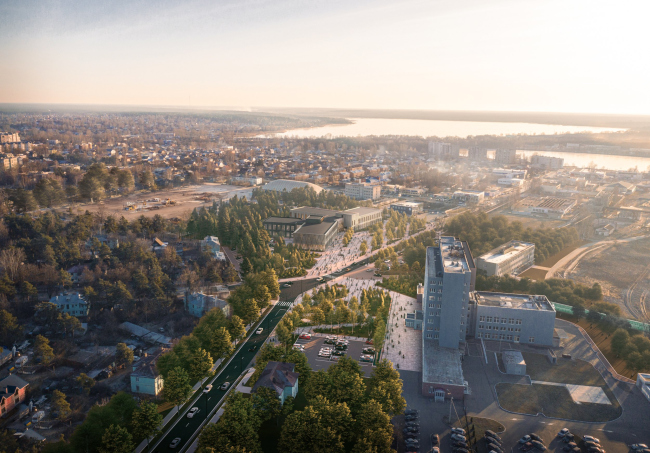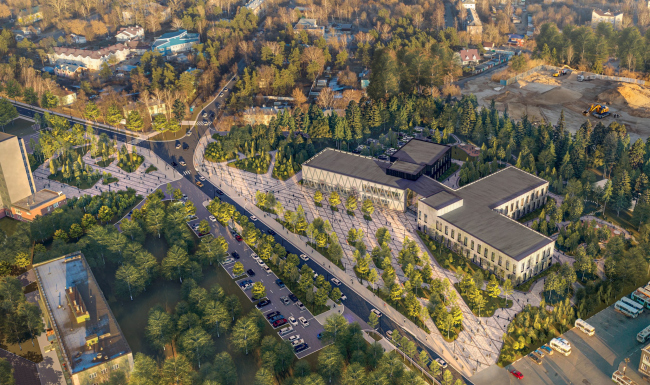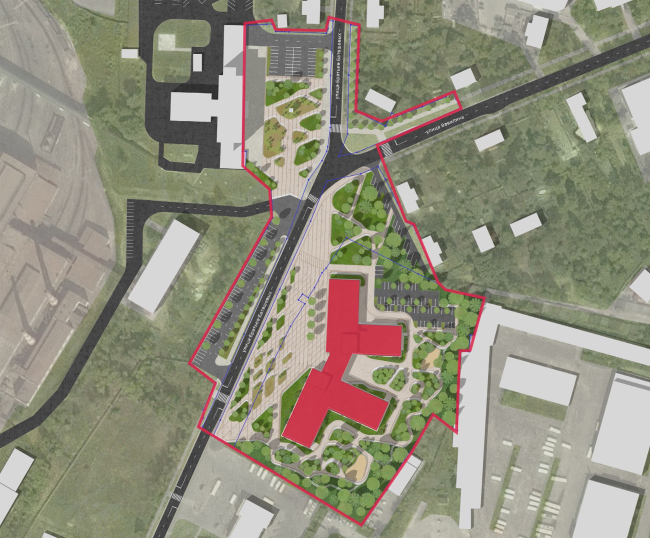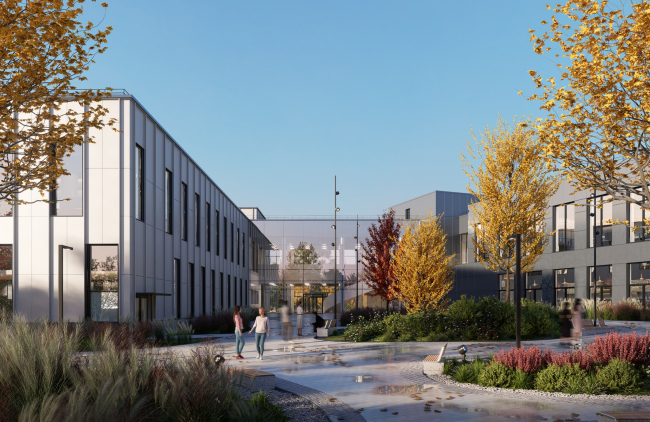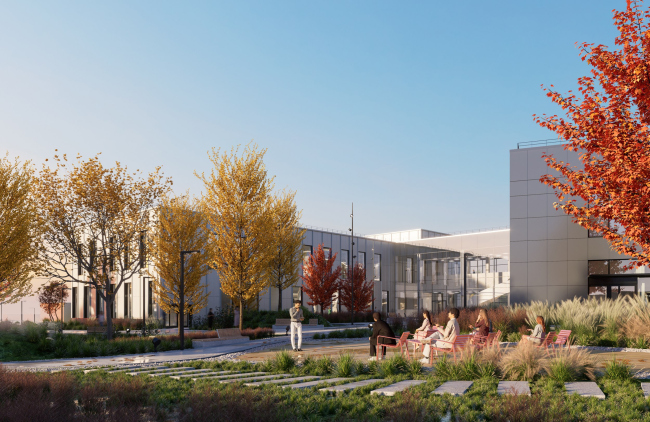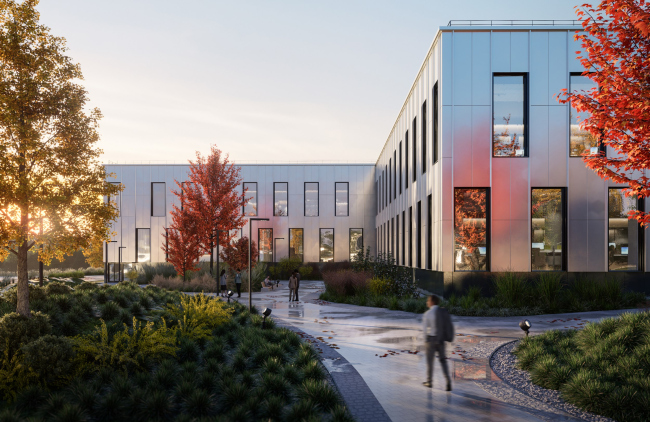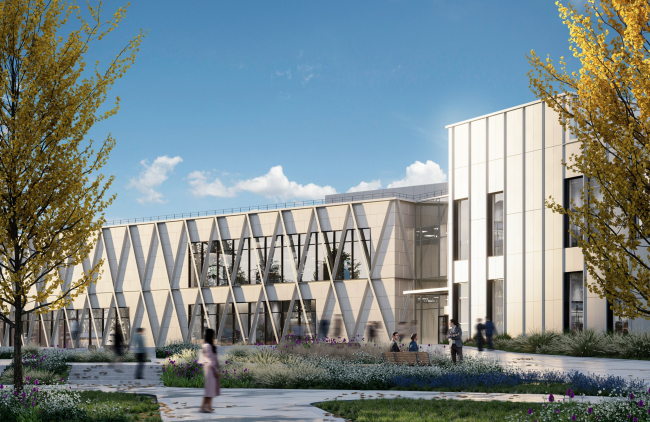|
Published on Archi.ru (https://archi.ru) |
|
| 11.04.2024 | |
|
In the Rhombus Grid |
|
|
Julia Tarabarina |
|
| Architect: | |
| Andrey Gnezdilov | |
| Studio: | |
| Ostozhenka Bureau | |
|
Construction has begun on the building of the OMK (United Metallurgical Company) Corporate University in Nizhny Novgorod’s town of Vyksa, designed by Ostozhenka Architects. The most interesting aspect of the project is how the architects immersed it in the context: “extracting” a diagonal motif from the planning grid of Vyksa, they aligned the building, the square, and the park to match it. A truly masterful work with urban planning context on several different levels of perception has long since become the signature technique of Ostozhenka. In the case of Vyksa, the fact that this town is a single-industry one is not a disadvantage but rather a plus. The OMK metallurgical company, which owns and operates the former Batashev plant, along with its “OMK-Participation” fund, has been organizing a contemporary art festival for many years here, arranging courtyards and bus stops according to projects by leading architects, restoring Shukhov structures, and also building “Shukhov Park” and the Museum of Metal, also known as the Center for Industrial Progress, next to the Batashev Palace.  Andrey Gnezdilov, Ostozhenka Bureau We were lucky to work on such a significant project for Vyksa. This building will be comfortable for everyone involved in the learning process. Vyksa’s powerful past is inextricably linked to the future, it is linked by people, and people must invent this future. This is the house where people will learn, dream and realize their dreams. OMK Corporate University in VyksaCopyright: © Ostozhenka ArchitectsOMK is currently developing education in the city: both school and vocational, collaborating with the MISIS University of Science and Technology in terms of personnel training, and training employees at the production facility in 210 (sic!) professions. The Corporate University is a continuation and development of the company’s branch of industrial education. It is being built opposite the factory entrance on Batashev Brothers Street, in the very place where the city meets the factory. The university is intended to be an extension of the factory and will teach not 210, but 600 specialties – from electromechanical engineering to production economics. About 500 people will be able to visit it daily, and the conference hall is designed for 600 seats.  Anatoly Sedykh, Chairman of the Board of Directors of OMK The corporate university will not only improve the quality of education, but will also transform the image of the city. The project has been prepared with great respect for Vyksa’s industrial heritage and refers us to the “Shukhov grid”, which is famous all over the world. The University is only a part of our social program to transform Vyksa. In the next five years, we will invest over 30 billion rubles in the development of the city, which means that the people who will study, live and work here will continue to strengthen the base that has supported Vyksa for over 260 years, the industry of our country and the Russian economy as a whole. The two-story building, covering an area of about 9000 sqm, consists of three units: educational, administrative, and public, assembled into two almost symmetrical L-shaped blocks and connected by a transparent double-height atrium with a spacious spiral staircase. 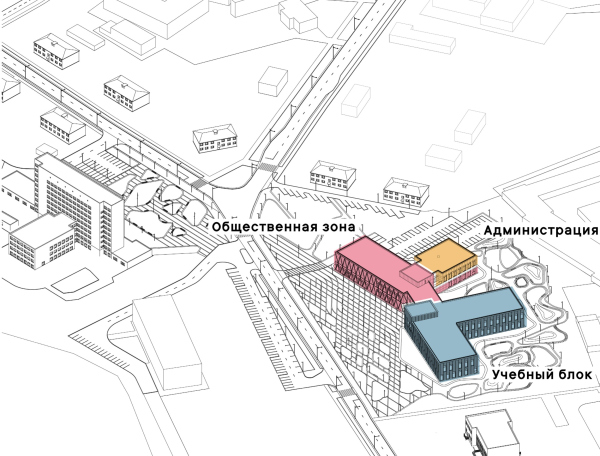 The functional layout. OMK Corporate University in Vyksa, the interiorCopyright: © Ostozhenka Architects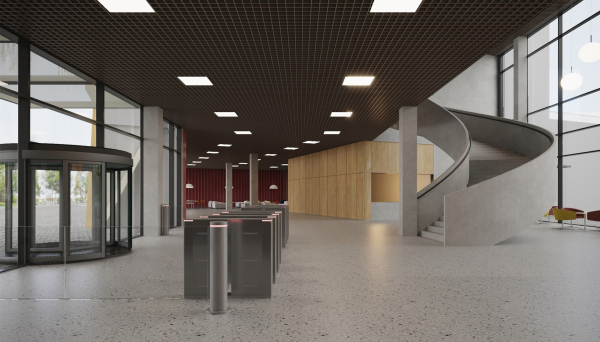 OMK Corporate University in Vyksa, the interiorCopyright: © Ostozhenka ArchitectsSince the buildings are placed at an angle, the plan forms a contour resembling a stylized figure with a flirtatiously set-aside “leg” – if we further indulge in fantasy, then the ten-story factory management building (situated slightly off to the side but still nearby) could be considered the “head” which, undoubtedly, is not entirely accurate. On the other hand, however, it’s immediately noticeable that the university inherits from the factory management building the logic of plan construction: the volumes constituting each of its “halves” are set at right angles to each other, one along the street, the other extending into the depth of the plot. 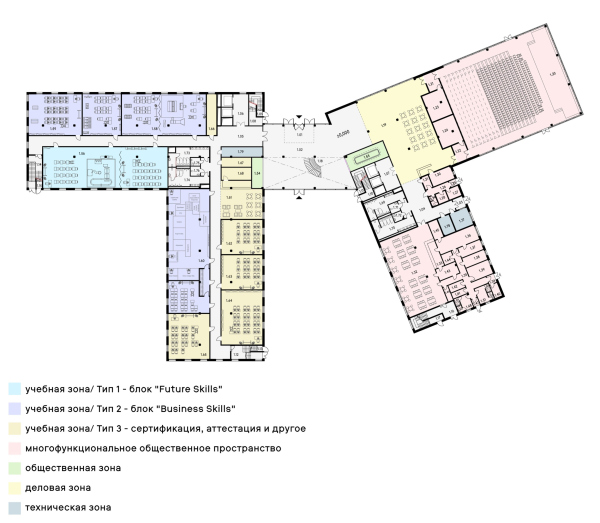 OMK Corporate University in VyksaCopyright: © Ostozhenka Architects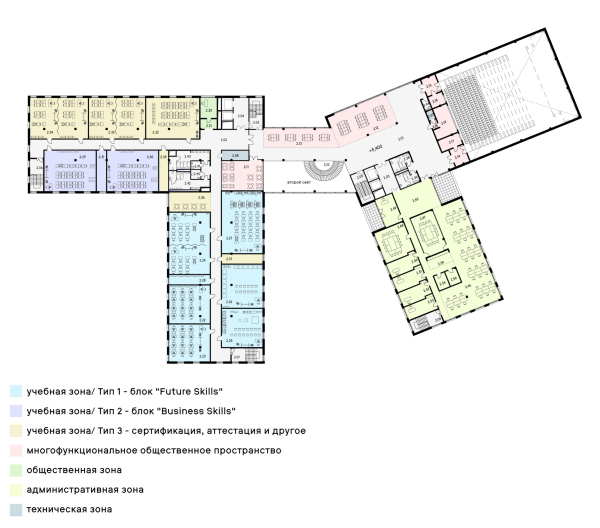 OMK Corporate University in VyksaCopyright: © Ostozhenka ArchitectsHowever, the most interesting aspect is where the intriguing slight turn of the two halves of the building in relation to each other comes from. Seriously – it’s anything but arbitrary! Architects love axial planning! And they are right to do so, because axial planning connects the city into a cohesive whole – both visually and conceptually. For example, the Batashev estate was oriented towards the axis of its park, which is now the “Central Park of Culture and Recreation”, and this axis, facing north-northeast, became the basis for the orthogonal planning of most of the city blocks. The estate and the city “look in the same direction”, and for Vyksa, this is more than true because they share a common goal. The second axis is the Navashino Highway, leading from Vyksa to the city of Murom and to the Oka River, along which historically metal which was produced here was transported. Along this highway, the factory’s territory grew during Soviet times, so this direction is no less crucial. The two main urban directions intersect at an angle of 40°, forming a diagonal grid of rhombuses – very similar to the grids designed by engineer Vladimir Shukhov, several examples of which are preserved in Vyksa. 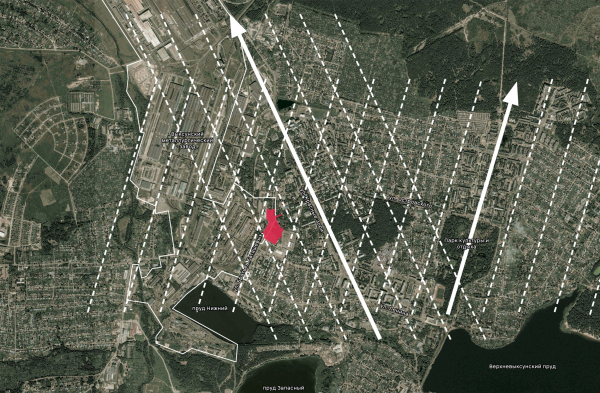 Scheme for the formation of volumetric and sculptural composition: city gridCopyright: © Ostozhenka Architects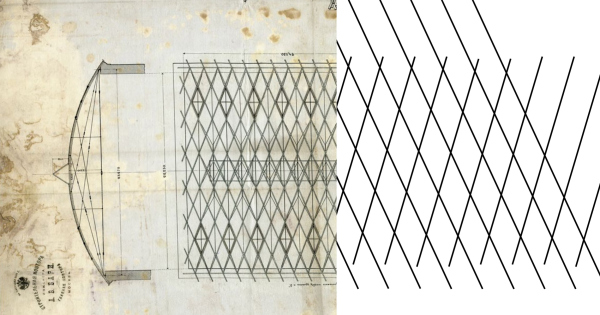 Comparison of the drawing of the Shukhov structure and the grid of the cityCopyright: © Ostozhenka ArchitectsThus, Vyksa, a city connected, among other things, with the memory of engineer Shukhov, finds itself “stitched” into a pattern akin to a classical Shukhov structure in terms of planning, and this circumstance elevates contextual connections to a new level, more sophisticated than mere resemblance to design grids. However, the planning idea is not exhausted by its beautiful semantic richness. The indicated turn, firstly, emphasizes the connection between the university building and the factory management building as the two main landmarks of the area, and secondly, forms a gently sloping triangular square in front of the entrance, making the urban environment in this place, crucial for Vyksa, noticeably more meaningful and organized. Meanwhile, the pattern of the diagonal grid in the paving captures, visualizes, and “anchors” the theme of grids, in abundance discovered by the architects in the city. OMK Corporate University in VyksaCopyright: © Ostozhenka ArchitectsThe “Navashino Highway axis” in the project transforms into a square in front of the factory management building, which continues the square in front of the university entrance on the other side of the street and forms a cohesive public space with it – the architects describe it as a “linear square”. On the university grounds behind the buildings, a small park is planned, which can be accessed through the atrium. Another axis is formed, a transverse one, which is also the axis of symmetry of the square, dividing the rhombuses of the diagonal grid in half.  The composition. OMK Corporate University in VyksaCopyright: © Ostozhenka Architects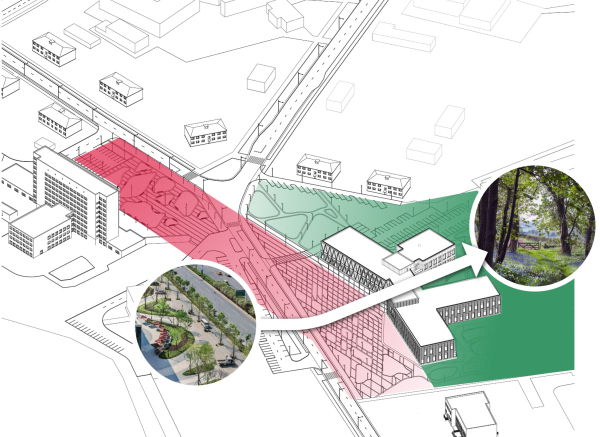 OMK Corporate University in VyksaCopyright: © Ostozhenka ArchitectsOMK Corporate University in VyksaCopyright: © Ostozhenka ArchitectsIn total, the project provides for improving two hectares of land. The architecture of the future university can be defined as light and restrainedly technological. The two-story atrium bridge is transparent on both sides, which should make the entrance permeable, and the view from the square to the park and from the park to the square almost unobstructed, visually unfolded in unison with the expanding depth arrangement of the buildings. OMK Corporate University in VyksaCopyright: © Ostozhenka ArchitectsOMK Corporate University in VyksaCopyright: © Ostozhenka ArchitectsThe facades are planned to be covered with silver matte aluminum – a material consonant with metallurgy itself, and also capable of capturing reflections without reflecting the surroundings, camouflaging by Gaussian blur. OMK Corporate University in VyksaCopyright: © Ostozhenka ArchitectsSuch a surface can remain clean and look new for a long time, symbolizing the innovative properties of metal and metallurgical production, which is in line with the goals and the main message of the corporate university. It is worth noting that if the Center for Industrial Progress, designed by Nikita Yaveyn, is indeed built two kilometers from here, near the Batashev estate, then the corporate university will form an interesting contrasting pair with it at two ends of the city: one rusted, artificially aged, and the other new and nobly shining. The design of all the volumes is subject to a unified theme, but they differ from each other. The “leg” of the administrative building, leading into the park, is slightly darker, the educational building is lighter, and the public building, combining the conference hall and the foyer, is covered with a diagonal grid. This is the most obvious and easily readable reference to Shukhov, a verbatim quote. And at the same time, the grid seems to “rise” on the façade from the square paving. OMK Corporate University in VyksaCopyright: © Ostozhenka ArchitectsExamining the project, one can imagine that its structure involves several levels of grid embodiment: the hypothetical level is “embedded” in the city plan; the “flat-and--decorative” level became the basis for the paving of the square and its visual organization – and if we recall the significance and impression made by the diagonal grid paving in the Capitol Square, landscaped by Michelangelo, then it becomes clear that the paving pattern is not a small thing in such instances. And the grid of diagonals in front of the conference hall façade is the most tangible embodiment of the same theme. In addition, in it, you can see another storyline: all other metal facades are decorated with vertical slats, not reaching very far out, but nevertheless organizing volumes with their uniform lines. So, looking at the building, especially from the square, one might think that on the public building, these strips decided to “fool around” a little, changing their direction and crisscrossing. There’s something light, park-like in this trick; it is not only read as an allusion to the industrial architecture of Shukhov, but it also resembles a garden pergola, enlarged manifold, yet still lightweight. OMK Corporate University in VyksaCopyright: © Ostozhenka ArchitectsIf we remember that there will be a park on the university grounds, including existing trees, and also that Vyksa still mainly consists of two-story houses with gardens and flower beds in the yards, with cherry trees blossoming in May – then this association with a pergola will seem not arbitrary at all but rather subtle and precise. The building stands on the border between a low-rise garden city and a huge factory – and the architects, apparently, captured and united both themes in it – one brutal, the other “lightweight”, bright, and airy. Pure magic, isn’t it? The interiors of the OMK University were designed by Frontarchitecture, and it seems that they have captured the main themes of the building. The interiors are simple and concise; a noticeable seriousness is added by the gray concrete color, black frames, and ceilings, while wood and natural light penetrating the corridors through glass walls provide “freshness”. It’s worth noting that the building is not entirely glass; in the walls of the educational and administrative buildings, we mostly see windows rather than continuous glazing. However, thanks to the glass walls of the corridors, at least in the 3D visuals, the interiors are moderately lit, not too bright, but filled with natural light. They look calm and rational. 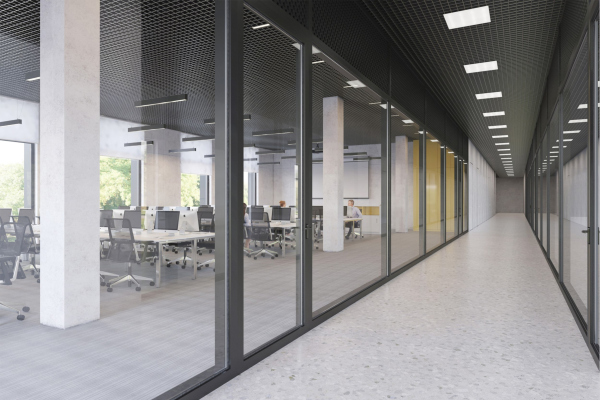 OMK Corporate University in Vyksa, the interiorCopyright: © Frontarchitecture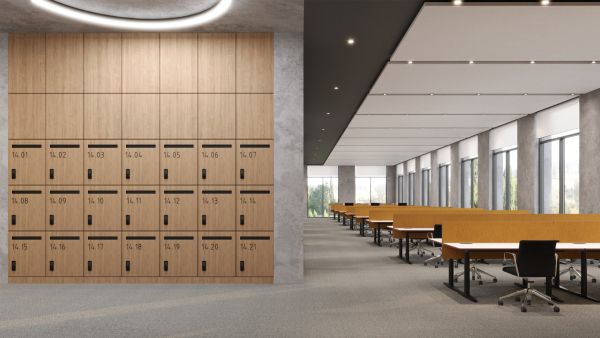 OMK Corporate University in Vyksa, the interiorCopyright: © FrontarchitectureThe two most striking interior solutions belong to the atrium and the conference hall. These are the spiral staircase of the two-story section and the luminous walls of the hall, including behind the stage. It will be possible to open and close it. Lighting behind the stage is one of the most popular ideas of our time; it was not implemented in the Zaryadye concert hall, but it was indeed implemented in the Warehouse Hall on the Spit of Nizhny Novgorod; let’s see what happens here. However, since the amphitheater is not intended for philharmonic music but for educational conferences and conventions, the probability of realizing a luminous band from three sides with a thin zigzag runner behind the glass strip is very high. 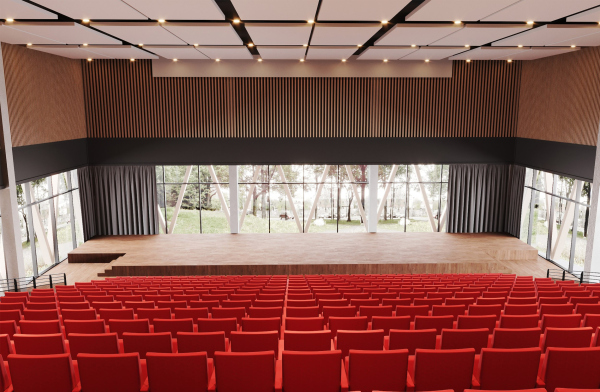 OMK Corporate University in Vyksa, the interiorCopyright: © Ostozhenka Architects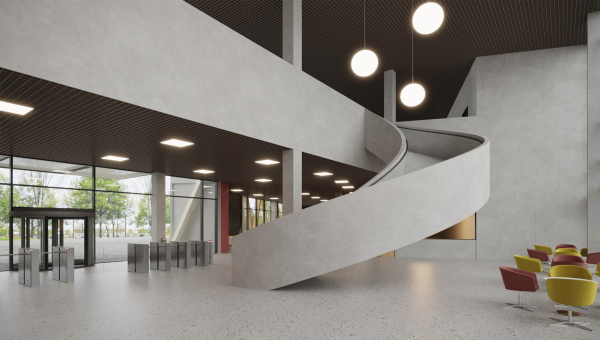 OMK Corporate University in Vyksa, the interiorCopyright: © FrontarchitectureThe construction has begun, and the building is scheduled to be completed in 2025 – for all intents and purposes, we will see it soon. |
|
